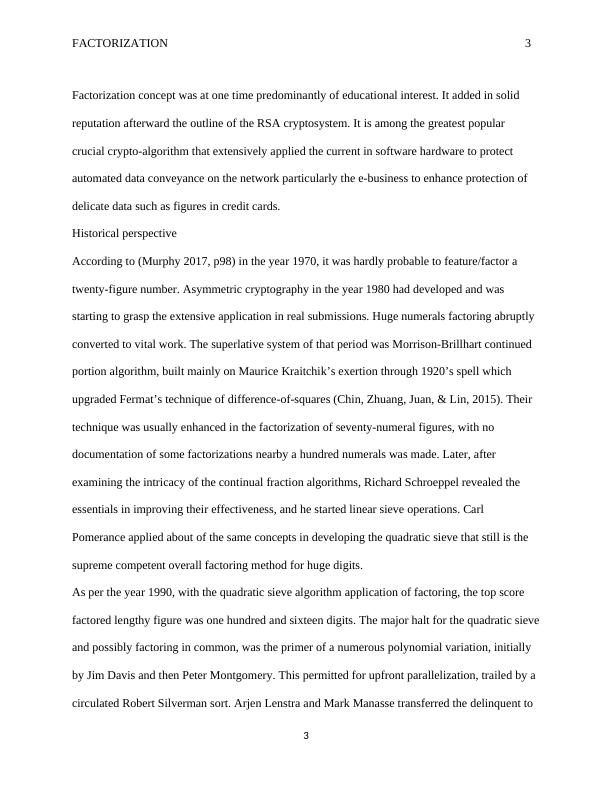Factorization in Cryptography: Historical Perspective, Applications, and Cons
Added on 2023-06-08
14 Pages4170 Words159 Views
Running head: FACTORIZATION 1
Factorization
Student’s Name
Institution
Factorization
Student’s Name
Institution

FACTORIZATION 2
Cryptography is a significant structuring block of electronic business schemes. Precisely,
cryptography tends utilization for guaranteeing the discretion, genuineness, and truthfulness of
data in an association. According to (Barker 2017, p67), in order to guard the sensitive
information in an organization, encryption should be applied in concealing raw information so
that the encoded data is utterly worthless excluding to the sanctioned persons having the accurate
decryption key, to reserve the legitimacy and truthfulness of information, the numeral autograph
is accomplished on the information in a manner that other individuals cannot imitate the right
signer nor adjust the engaged data without detection. Current lopsided basic cryptography
utilizes scientific procedures that are relatively cool to enhance in one way, but particularly stiff
to improve the contrary application of the same concept. The typical example applied in the case
is a prime factorization concept. Huge primes have at least single practical submission, and they
tend to be used in the construction of cryptosystems (public key) that also are recognized as
irregular cryptosystems and exposed cryptosystems (encryption key). Dual simple kinds of
public-key structures appeared in 1970s; Diffie-Hellman (DH) for crucial contract procedure
anticipated in the year 1975 that depend on the rigidity of Discrete Logarithm Problem (DLP).
After two years at MIT, Rivest, Shamir, and Alderman in America projected the critical
conveyance and digital autograph structures referred by their abbreviations as RSA that grosses
it safety as of the stiffness of the Integer Factorization Problem (IFP). Provided with dual large
prime records p and q, it is an upfront duty to product them and has the multiplied result, n = (p •
q). Though, provided with a bulky complex integer that is a multiplication of double huge prime
aspects, it is tremendously hard to get the two summits figures (Brisson 2017, p34).
2
Cryptography is a significant structuring block of electronic business schemes. Precisely,
cryptography tends utilization for guaranteeing the discretion, genuineness, and truthfulness of
data in an association. According to (Barker 2017, p67), in order to guard the sensitive
information in an organization, encryption should be applied in concealing raw information so
that the encoded data is utterly worthless excluding to the sanctioned persons having the accurate
decryption key, to reserve the legitimacy and truthfulness of information, the numeral autograph
is accomplished on the information in a manner that other individuals cannot imitate the right
signer nor adjust the engaged data without detection. Current lopsided basic cryptography
utilizes scientific procedures that are relatively cool to enhance in one way, but particularly stiff
to improve the contrary application of the same concept. The typical example applied in the case
is a prime factorization concept. Huge primes have at least single practical submission, and they
tend to be used in the construction of cryptosystems (public key) that also are recognized as
irregular cryptosystems and exposed cryptosystems (encryption key). Dual simple kinds of
public-key structures appeared in 1970s; Diffie-Hellman (DH) for crucial contract procedure
anticipated in the year 1975 that depend on the rigidity of Discrete Logarithm Problem (DLP).
After two years at MIT, Rivest, Shamir, and Alderman in America projected the critical
conveyance and digital autograph structures referred by their abbreviations as RSA that grosses
it safety as of the stiffness of the Integer Factorization Problem (IFP). Provided with dual large
prime records p and q, it is an upfront duty to product them and has the multiplied result, n = (p •
q). Though, provided with a bulky complex integer that is a multiplication of double huge prime
aspects, it is tremendously hard to get the two summits figures (Brisson 2017, p34).
2

FACTORIZATION 3
Factorization concept was at one time predominantly of educational interest. It added in solid
reputation afterward the outline of the RSA cryptosystem. It is among the greatest popular
crucial crypto-algorithm that extensively applied the current in software hardware to protect
automated data conveyance on the network particularly the e-business to enhance protection of
delicate data such as figures in credit cards.
Historical perspective
According to (Murphy 2017, p98) in the year 1970, it was hardly probable to feature/factor a
twenty-figure number. Asymmetric cryptography in the year 1980 had developed and was
starting to grasp the extensive application in real submissions. Huge numerals factoring abruptly
converted to vital work. The superlative system of that period was Morrison-Brillhart continued
portion algorithm, built mainly on Maurice Kraitchik’s exertion through 1920’s spell which
upgraded Fermat’s technique of difference-of-squares (Chin, Zhuang, Juan, & Lin, 2015). Their
technique was usually enhanced in the factorization of seventy-numeral figures, with no
documentation of some factorizations nearby a hundred numerals was made. Later, after
examining the intricacy of the continual fraction algorithms, Richard Schroeppel revealed the
essentials in improving their effectiveness, and he started linear sieve operations. Carl
Pomerance applied about of the same concepts in developing the quadratic sieve that still is the
supreme competent overall factoring method for huge digits.
As per the year 1990, with the quadratic sieve algorithm application of factoring, the top score
factored lengthy figure was one hundred and sixteen digits. The major halt for the quadratic sieve
and possibly factoring in common, was the primer of a numerous polynomial variation, initially
by Jim Davis and then Peter Montgomery. This permitted for upfront parallelization, trailed by a
circulated Robert Silverman sort. Arjen Lenstra and Mark Manasse transferred the delinquent to
3
Factorization concept was at one time predominantly of educational interest. It added in solid
reputation afterward the outline of the RSA cryptosystem. It is among the greatest popular
crucial crypto-algorithm that extensively applied the current in software hardware to protect
automated data conveyance on the network particularly the e-business to enhance protection of
delicate data such as figures in credit cards.
Historical perspective
According to (Murphy 2017, p98) in the year 1970, it was hardly probable to feature/factor a
twenty-figure number. Asymmetric cryptography in the year 1980 had developed and was
starting to grasp the extensive application in real submissions. Huge numerals factoring abruptly
converted to vital work. The superlative system of that period was Morrison-Brillhart continued
portion algorithm, built mainly on Maurice Kraitchik’s exertion through 1920’s spell which
upgraded Fermat’s technique of difference-of-squares (Chin, Zhuang, Juan, & Lin, 2015). Their
technique was usually enhanced in the factorization of seventy-numeral figures, with no
documentation of some factorizations nearby a hundred numerals was made. Later, after
examining the intricacy of the continual fraction algorithms, Richard Schroeppel revealed the
essentials in improving their effectiveness, and he started linear sieve operations. Carl
Pomerance applied about of the same concepts in developing the quadratic sieve that still is the
supreme competent overall factoring method for huge digits.
As per the year 1990, with the quadratic sieve algorithm application of factoring, the top score
factored lengthy figure was one hundred and sixteen digits. The major halt for the quadratic sieve
and possibly factoring in common, was the primer of a numerous polynomial variation, initially
by Jim Davis and then Peter Montgomery. This permitted for upfront parallelization, trailed by a
circulated Robert Silverman sort. Arjen Lenstra and Mark Manasse transferred the delinquent to
3

FACTORIZATION 4
the Internet, wherein the year 1994, the RSA (129-digit) number contest tend factorization
utilizing the sluggish time on over 1600 processors (Domanov & De Lathauwer 2016, p56). It
had been predictable in the year 1976, to be in safety for forty quadrillion years. Pollard’s
number field sieve substituted the quadratic sieve in the year 1996. Number Field Sieve (NFS) is
presently at the leading edge of exploration hooked on numeral algorithm proficient in factoring
huge compound digits over one-hundred numerals. The existing top score in factoring a usually
stiff integers is that of the two hundred fraction ciphers contest digit from RSA data Safety, Inc.,
RSA-200 that tends accomplishment through General Number Field Sieve (GNFS). Amongst the
Cunningham numerals, the highest notion is the factorization of two hundred and forty-eight
decimal digit integer by Special Number Field Sieve (SNFS)
Consequently, the standard notion is the “n” magnitude would be selected in a manner that the
period and price for executing the factorization tops the worth of the secured/encrypted data
(Meletiou, Triantafyllou & Vrahatis 2015, p37). But even then, extreme overhaul must quiet
enhanced in the general crypto-scheme, as present expansion in numeral factorization has
increased much quicker than foreknown and it is a hazardous issue for crypto-engineers to
endeavor upon measurable predictions in this ground.
Furthermore, an individual ought to comprehend that it at all times vestiges likely that a fresh
computational technique could be designed from the unsuspicious section that brands factoring
stress-free fortuitously or inappropriately liable on which zone one is on, and no one recognizes
how to construct one yet. According to (Ginot 2015, p430) however, in cryptography, it tends to
warn that factoring large figures is a difficult task but not as previous. This has severe
repercussions for the efficiency of cryptography (public-key) that depend on the exertion of
factoring huge bases for the aforementioned safety. Currently, the intelligent crypto-designer is
4
the Internet, wherein the year 1994, the RSA (129-digit) number contest tend factorization
utilizing the sluggish time on over 1600 processors (Domanov & De Lathauwer 2016, p56). It
had been predictable in the year 1976, to be in safety for forty quadrillion years. Pollard’s
number field sieve substituted the quadratic sieve in the year 1996. Number Field Sieve (NFS) is
presently at the leading edge of exploration hooked on numeral algorithm proficient in factoring
huge compound digits over one-hundred numerals. The existing top score in factoring a usually
stiff integers is that of the two hundred fraction ciphers contest digit from RSA data Safety, Inc.,
RSA-200 that tends accomplishment through General Number Field Sieve (GNFS). Amongst the
Cunningham numerals, the highest notion is the factorization of two hundred and forty-eight
decimal digit integer by Special Number Field Sieve (SNFS)
Consequently, the standard notion is the “n” magnitude would be selected in a manner that the
period and price for executing the factorization tops the worth of the secured/encrypted data
(Meletiou, Triantafyllou & Vrahatis 2015, p37). But even then, extreme overhaul must quiet
enhanced in the general crypto-scheme, as present expansion in numeral factorization has
increased much quicker than foreknown and it is a hazardous issue for crypto-engineers to
endeavor upon measurable predictions in this ground.
Furthermore, an individual ought to comprehend that it at all times vestiges likely that a fresh
computational technique could be designed from the unsuspicious section that brands factoring
stress-free fortuitously or inappropriately liable on which zone one is on, and no one recognizes
how to construct one yet. According to (Ginot 2015, p430) however, in cryptography, it tends to
warn that factoring large figures is a difficult task but not as previous. This has severe
repercussions for the efficiency of cryptography (public-key) that depend on the exertion of
factoring huge bases for the aforementioned safety. Currently, the intelligent crypto-designer is
4

End of preview
Want to access all the pages? Upload your documents or become a member.